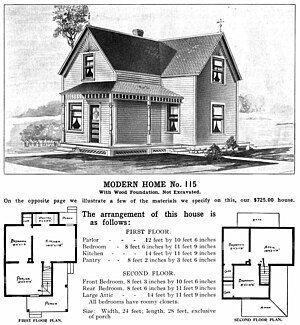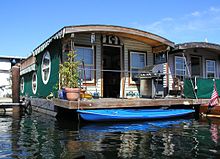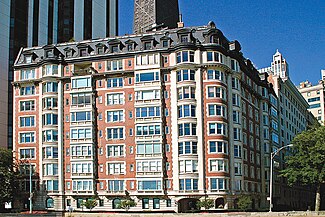Home
The examples and perspective in this article may not represent a worldwide view of the subject. (December 2021) |

| Part of a series on |
| Living spaces |
|---|
 |
A home, or domicile, is a
Physical forms of homes can be static such as a house or an apartment, mobile such as a houseboat, trailer or yurt or digital such as virtual space.[1] The aspect of 'home' can be considered across scales; from the micro scale showcasing the most intimate spaces of the individual dwelling and direct surrounding area to the macro scale of the geographic area such as town, village, city, country or planet.
The concept of 'home' has been researched and theorized across disciplines – topics ranging from the idea of home, the interior, the psyche, liminal space, contested space to gender and politics.[2] The home as a concept expands beyond residence as contemporary lifestyles and technological advances redefine the way the global population lives and works.[citation needed] The concept and experience encompasses the likes of exile, yearning, belonging, homesickness and homelessness.[3]
History
Prehistoric era
The earliest homes that humans inhabited were likely naturally occurring features such as
The first early hominid ever found in Africa, the
In southern Africa, early modern humans regularly used sea caves as shelter starting about 180,000 years ago when they learned to exploit the sea for the first time.
Ancient era
This section is empty. You can help by adding to it. (December 2021) |
Post-classical era
From the 14th to the 16th century, homelessness was perceived of as a "vagrancy problem" and legislative responses to the problem were predicated upon the threat it may pose to the state.[8]
Modern era

According to Kirsten Gram-Hanssen, "It can be argued that historically and cross-culturally there is not always [a] strong relation between the concept of home and the physical building, and that this mode of thinking is rooted in the Enlightenment of the seventeenth century".[10] Before, one's home was more public than private; traits such as privacy, intimacy and familiarity would proceed to achieve greater prominence, aligning the concept with the bourgeoisie.[11][12] The connection between home and house was reinforced by a case law declaration from Edward Coke: "The house of everyman is to him as his castle and fortress, as well as his defense against injury and violence, as for his repose". Colloquially, this was adapted into the phrase "The Englishman's home is his castle" which popularised the notion of home as house.[13]
A result of the longstanding association between home and women, 18th century English women, of upper-class status, were scorned for pursuing activities outside of the home, thus seen to be of undesirable character.[14] The concept of home took on unprecedent prominence by the 18th century, reified by cultural practice.[15]
The concept of a smart home arose in the 19th century in turn with electricity having been introduced to homes in a limited capacity.[10] The distinction between home and work formulated in the 20th century, with home acting as sanctuary.[16] Modern definitions portray home as a site of supreme comfort and familial intimacy, operating as a buffer to the greater world.[14]
Common types
The concept of home is one with multiple interpretations, influenced by one's history and identity.[17] People of differing ages, genders, ethnicities and classes may have resultingly different meanings of home.[18] Commonly, it is associated with various forms of abodes such as wagons, cars, boats or tents although it is equally considered to extend beyond the space, in mind and emotion.[8][19][20] The space of a home need not be significant or fixed though the boundaries of home are often tied to the space.[19][20] There have been multiple theories regarding one's choice of home with the residential conditions of their childhood often reflected in their later choice of home.[11] According to Paul Oliver, the vast majority of abodes are vernacular, constructed in accordance with the residents' needs.[21]
House

A house is a single-unit residential building. It may range in complexity from a rudimentary hut to a complex structure of wood, masonry, concrete or other material, outfitted with plumbing, electrical, and heating, ventilation, and air conditioning systems.[22][23]
The social unit that lives in a house is known as a
Joseph Rykwert distinguished between home and house in their physicality; a house requires a building whereas a home does not.[24] Home and house are often used interchangeably, although their connotations may differ: house being "emotionally neutral" and home evoking "personal, cognitive aspects".[20][25] By the mid-18th century, the definition of home had extended beyond a house.[15] "Few English words are filled with the emotional meaning of the word home".[14]
Moveable structures


Home as constitutionally mobile and transient has been contended by anthropologists and sociologist.[26] A mobile home (also known as a house trailer, park home, trailer, or trailer home) is a prefabricated structure, built in a factory on a permanently attached chassis before being transported to site (either by being towed or on a trailer). Used as permanent homes, or for holiday or temporary accommodation, they are often left permanently or semi-permanently in one place, but can be moved, and may be required to move from time to time for legal reasons.
A
A traditional yurt or ger is a portable round tent covered with skins or felt and used as a dwelling by several distinct nomadic groups in the steppes of Central Asia. The structure consists of an angled assembly or latticework of wood or bamboo for walls, a door frame, ribs (poles, rafters), and a wheel (crown, compression ring) possibly steam-bent. The roof structure is often self-supporting, but large yurts may have interior posts supporting the crown. The top of the wall of self-supporting yurts is prevented from spreading by means of a tension band which opposes the force of the roof ribs. Modern yurts may be permanently built on a wooden platform; they may use modern materials such as steam-bent wooden framing or metal framing, canvas or tarpaulin, plexiglass dome, wire rope, or radiant insulation.
Management
Housing cooperative

A
The cooperative is membership based, with membership granted by way of a share purchase in the cooperative. Each shareholder in the legal entity is granted the right to occupy one housing unit. A primary advantage of the housing cooperative is the pooling of the members' resources so that their buying power is leveraged; thus lowering the cost per member in all the services and products associated with home ownership.Repair

Housekeeping
Housekeeping is the management and routine support activities of running and maintaining an organized physical institution occupied or used by people, like a house, ship, hospital or factory, such as cleaning, tidying/organizing, cooking, shopping, and bill payment. These tasks may be performed by members of the household, or by persons hired for the purpose. This is a more broad role than a cleaner, who is focused only on the cleaning aspect.[30] The term is also used to refer to the money allocated for such use.[31] By extension, it may also refer to an office or a corporation, as well as the maintenance of computer storage systems.[32]
The basic concept can be divided into domestic housekeeping, for private households, and institutional housekeeping for commercial and other institutions providing shelter or lodging, such as hotels, resorts, inns, boarding houses, dormitories, hospitals and prisons.[33][34] There are related concepts in industry known as workplace housekeeping and Industrial housekeeping, which are part of occupational health and safety processes.
ATenure
Housing tenure is a financial arrangement and ownership structure under which someone has the right to live in a house or apartment. The most frequent forms are tenancy, in which rent is paid by the occupant to a landlord, and owner-occupancy, where the occupant owns their own home. Mixed forms of tenure are also possible.
The basic forms of tenure can be subdivided, for example an owner-occupier may own a house outright, or it may be
Owner-occupancy
Rental accommodation
Squatting

In
Homelessness

The state of being without a home can occur in many ways,
The dichotomy between home and homelessness is to the extent that the concept of home, scholars have said, is dependent on homelessness: "in a sense, without homelessness, we would not be concerned with what home means".[41]
Anthropogenic significance

The connection between humans and dwelling is profound, such that, the likes of Gaston Bachelard and Martin Heidegger consider it an "essential characteristic" of humanity.[25] A home is generally a place that is close to the heart of the owner, and can become a prized possession. It has been argued that psychologically "The strongest sense of home commonly coincides geographically with a dwelling. Usually, the sense of home attenuates as one moves away from that point, but it does not do so in a fixed or regular way."[43] A person's conception of home can be dependent on congealing conditions, such as culture, geography or emotion; the sense of being at home may be contingent upon the presence of multiple emotions, such as joy, sorrow, nostalgia and pride.[44][45] Further psychological interperation contends that homes serve the purpose of satisfying identity-based desires and expression and that it functions as a "symbol of the self", bound to the events of one's life.[18][46] Emmanuel Levinas wrote of home as where, upon seclusion from the greater world, a sense of self can be regained.[47]
There exist many connotations regarding the concept of a home, including of security, identity, ritual and socialisation, varied definitions and residents may associate their home with meanings, emotions, experiences and relationships.
In modern America, an owned house has greater cachet as a home than other residences; debate exists as to if a rooming house can provide a home.[11][55] Some housing scholars have contended that a conflation of house and home is the result of popular media and capitalist interest.[13] Differing cultures may perceive the concept of a home differently, ascribing less value to the privacy of a residence or the residence itself – although housing issues have been seen as of great concern to immigrants.[11][b] The home can render to men and women in significant differences: men conditioned to experience great control and little labour and vice versa for women; homelessness too can be subject to differences per gender.[8][41] Sociologist Shelley Mallett preposed the idea of home as abstractions: space, feeling, praxis or "a way of being in the world".[11] Abstract notions of home are present in the proverb "A house is not a home".[41]
Since it can be said that humans are generally creatures of
See also
- Human habitats (Category)
- Ancestral home
- ARCHIVE Global
- Home automation
- Home network
- Home improvement
- Home repair
- Homemaking
- Housing
- List of countries by home ownership rate
- List of human habitation forms
- Show house
- United Nations Human Settlements Programme
Notes
- ^ Alienation based sense of homelessness can extend to nations and communities; Bell Hooks wrote of an African-American sense of homeless in the American South.[41]
- ^ The word for home may not be present in all cultures and languages.[21]
- ^ Research showcases that "women's attachment to home is more pronounced than men's and increases with the length of time spent at home".[57]
References
- ^ "Definition: Home". Dictionary. Archived from the original on 28 October 2020. Retrieved 29 October 2020.
- ISBN 978-0802099686.
- JSTOR 10.3138/j.ctt2ttqbw.
- S2CID 29825617. Archived from the original(PDF) on 22 September 2018. Retrieved 22 September 2018.
- from the original on 22 September 2018. Retrieved 22 September 2018.
- ISBN 978-1-888729-16-0. Archivedfrom the original on 21 May 2021. Retrieved 2 December 2020.
- ^ "Skara Brae". Orkneyjar. Archived from the original on 9 December 2012. Retrieved 8 December 2012.
- ^ S2CID 143737438.
- ^ City of Helsinki (2022): Display captions in the Worker Housing Museum.
- ^ S2CID 115664299.
- ^ S2CID 153491629.
- S2CID 146596570.
- ^ S2CID 141848481.
- ^ JSTOR 25483038.
- ^ S2CID 145277189.
- S2CID 143978616.
- ISBN 978-1-137-58801-2.
- ^ S2CID 52216934.
- ^ JSTOR 40970644.
- ^ S2CID 142644798.
- ^ S2CID 52996532.
- ^ Schoenauer, Norbert (2000). 6,000 Years of Housing (rev. ed.) (New York: W.W. Norton & Company).
- ^ "housing papers" (PDF). clerk.house.gov. Archived from the original (PDF) on 17 January 2013. Retrieved 18 December 2012.
- JSTOR 40970630.
- ^ PMID 21221813.
- S2CID 143558011.
- ISBN 0917376463.
- ^ Gabor, M. (1979). Houseboats from Floating Places to Humble Dwellings – a glowing tribute to a growing lifetsyle. Toronto: Ballantine Books.
- ^ "What is a housing cooperative". Robinhood Learn. Retrieved 4 July 2023.
- ^ "What's the Difference Between Housekeeping and Cleaning". ThinkACW. 21 December 2017.
- ^ "housekeeping" Oxford Dictionaries Online. Retrieved 2 June 2013.
- The Collins English Dictionary. Retrieved 2 June 2013.
- ^ "Housekeeping". www.collinsdictionary.com. Retrieved 12 October 2022.
- ^ "National Guidelines for Clean Hospitals" (PDF). Ministry of Health and Family Welfare, Government of India. 2015. Retrieved 12 October 2022.
- ^ "housekeeper" Oxford Dictionaries Online. Retrieved 2 June 2013.
- ^ Mrs. Beeton's Book of Household Management Web version of the book at the University of Adelaide Library. Retrieved 2 June 2013.
- ^ Koren, Liran (13 April 2022). "Owner-Occupied vs. Non-Owner-Occupied Real Estate: What's the Difference?". Luxury Property Care. Retrieved 28 July 2023.
- ^ "Definition of HIRE". www.merriam-webster.com. Retrieved 3 May 2023.
- ^ "Definition of LET". www.merriam-webster.com. Retrieved 3 May 2023.
- . Retrieved 3 May 2023.
- ^ S2CID 143034264.
- ^ Teves, Hranjski, Oliver, Hrvoje (7 December 2012). "Death toll from Philippine typhoon climbs past 500". USA Today. Archived from the original on 8 December 2012. Retrieved 8 December 2012.
{{cite news}}: CS1 maint: multiple names: authors list (link) - JSTOR 215276.
- ISSN 0264-3758.
- S2CID 143640713.
- JSTOR 43029026.
- S2CID 74202738.
- S2CID 145718750.
- S2CID 233665944.
- S2CID 154629854.
- .
- PMID 28556696.
- JSTOR 40970641.
- S2CID 145429727.
- S2CID 143568957.
- ISBN 978-92-871-6308-0. Archivedfrom the original on 10 June 2016. Retrieved 19 November 2015.
- ^ S2CID 4730207.
- ^ Haywood, Trudy (27 July 2017). "Homesickness – Settling in to University". Warwick. Archived from the original on 4 January 2018.
- ^ Burton-Christie, Douglas (2009). "Place-Making as Contemplative Practice". Anglican Theological Review. 91 (3): 347–371. Archived from the original on 2 May 2014. Retrieved 30 April 2014.
- S2CID 143282245.
- S2CID 146220746.

